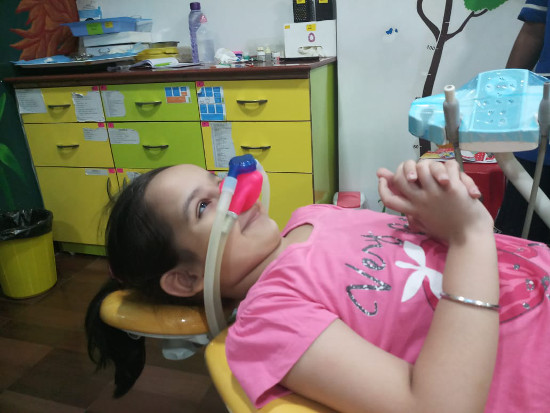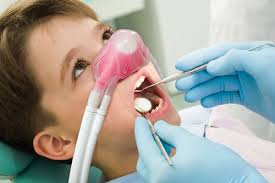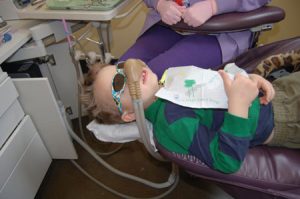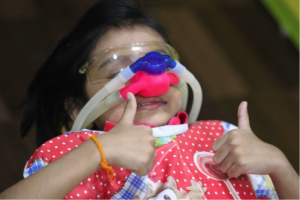Conscious Sedation or Nitrous Oxide Sedation
- Nitrous oxide – oxygen inhalation sedation is one of the safest sedative treatment in pediatric sedation dentistry. It has a rapid onset, and the effects wear off almost immediately.
- The American Academy of Pediatric Dentistry endorses the use of nitrous oxide/oxygen inhalation therapy as a safe and effective technique to reduce anxiety and decrease pain in children.
- The gas (a mixture of nitrous oxide and oxygen) is administered by inhaling a sweet, pleasant aroma through a nasal mask. Laughing gas is considered a form of “conscious sedation” because patients will still be awake, but they will feel relaxed.
- Your child will be able to breathe normally and respond to verbal talk from our dentists, but they will feel no pain. Depending on the level and form of sedation received, the patient may not remember the visit at all.
- At Kammath’s Dental Care, we have this unique facility , which helps us in providing an anxiety free visit for our cute little patients and their parents.
Pediatric Sedation Dentistry: When and Why It’s Recommended
What Is Paediatric Sedation?
Paediatric sedation is a specialized approach in dentistry that uses medication to help children relax, feel comfortable, and remain calm during dental treatments. At Dr. Kammath’s Paediatric Dental Clinic, paediatric sedation is administered by trained professionals to ensure a safe and positive experience for every child. The primary goal is to reduce anxiety, manage pain, and allow children to receive necessary dental care without fear or distress. Sedation does not always mean the child is asleep; in most cases, children remain awake but are deeply relaxed and less aware of the procedure.
When Is Sedation Recommended for Children?
Sedation is not needed for every dental visit, but there are specific situations where it is highly beneficial for children:
Severe Dental Anxiety or Phobia: It’s common for children to feel intense fear or nervousness about visiting the dentist. Sedation can help them relax, making their dental appointments much less stressful and far more comfortable.
Extensive or Complex Procedures: For treatments such as tooth extractions, root canals, or multiple fillings, sedation allows the dentist to work efficiently and safely, minimizing discomfort and reducing the number of appointments needed.
Young Age or Inability to Cooperate: Some children, especially very young ones, may have difficulty sitting still or following instructions for extended periods. Sedation helps them remain calm and still, ensuring the procedure can be completed safely.
Special Healthcare Needs: Children with physical, developmental, or behavioural conditions may benefit from sedation to receive the dental care they need without distress or risk of injury.
Strong Gag Reflex or Sensitivity: Sedation can help children with sensitive gag reflexes or heightened oral sensitivity tolerates dental procedures more comfortably.
Types of Sedation Used in Paediatric Dentistry
At Dr. Kammath’s Paediatric Dental Clinic, several types of paediatric sedation are available, each tailored to the child’s specific needs and the complexity of the procedure:
NOIS (Nitrous Oxide Inhalation Sedation)/Happy Gas Therapy: This gentle sedative is administered through a mask, allowing children to stay calm and relaxed while still being awake and alert. Its calming effects fade rapidly once the procedure is finished.
Oral Sedation: Administered as a liquid or pill, oral sedation makes children drowsy but awake. It is commonly used for moderate anxiety or longer procedures.
Intranasal sedation: A gentle, needle-free method using medication administered through the nose. It offers rapid onset, effective anxiety relief, and improved cooperation for children during dental procedures, making visits calmer and safer for young patients.
Intravenous (IV) Sedation: Delivered directly into the bloodstream, IV sedation is used for more complex treatments or when a deeper level of relaxation is required. The child may be sleepy but can still respond to verbal cues.
General Anesthesia: Reserved for extensive dental work or children with special needs, general anesthesia renders the child fully unconscious. It is performed in a hospital or a specialized setting with close monitoring by an anesthesiologist.
The type of sedation selected is based on factors such as the child’s age, medical background, degree of anxiety, and the specific dental treatment required.
Preparing Your Child for Sedation: What Parents Should Know
Preparation is the key to a smooth and safe sedation experience. Here’s what parents should do before their child’s appointment:
Follow Pre-Sedation Instructions: Your dentist will provide guidelines regarding eating and drinking before the procedure. It is crucial to follow these instructions to reduce the risk of complications during sedation.
Discuss Medical History: Inform the dental team about your child’s medical conditions, allergies, and any medications they are taking. Providing this information allows the dentist to select the safest and most suitable sedation method for your child.
Explain the Process: Talk to your child about what to expect in simple, reassuring terms. Reassure them that the dentist’s goal is to make them feel comfortable and that you will be close by throughout the visit.
Bring Comfort Items: A favourite toy or blanket can help your child feel secure before and after the procedure.
Plan for Recovery: After sedation, your child may feel drowsy or unsteady. Arrange for transportation home and allow your child to rest for the remainder of the day.
Is Sedation Safe for Kids?
Safety is the top priority at Dr. Kammath’s Paediatric Dental Clinic. Paediatric sedation is considered very safe when administered by experienced professionals in a controlled environment. The dental team monitors your child’s vital signs throughout the procedure, ensuring their well-being at every step. Modern sedation techniques are designed to minimize risks, and most children recover quickly with no lasting effects.
Potential side effects, such as mild nausea or grogginess, are usually temporary. Serious complications are rare, especially when parents follow all pre- and post-sedation instructions and the child’s health history is carefully reviewed.
Conclusion
Paediatric sedation dentistry at Dr. Kammath’s Paediatric Dental Clinic offers a safe, effective way to help children receive essential dental care without fear or discomfort. Whether your child is anxious, has special needs, or requires complex treatment, paediatric sedation can transform their dental experience into a positive one-setting the foundation for a lifetime of healthy smiles. If you have questions about paediatric sedation or want to know if it’s right for your child, our caring team is here to guide you every step of the way.










